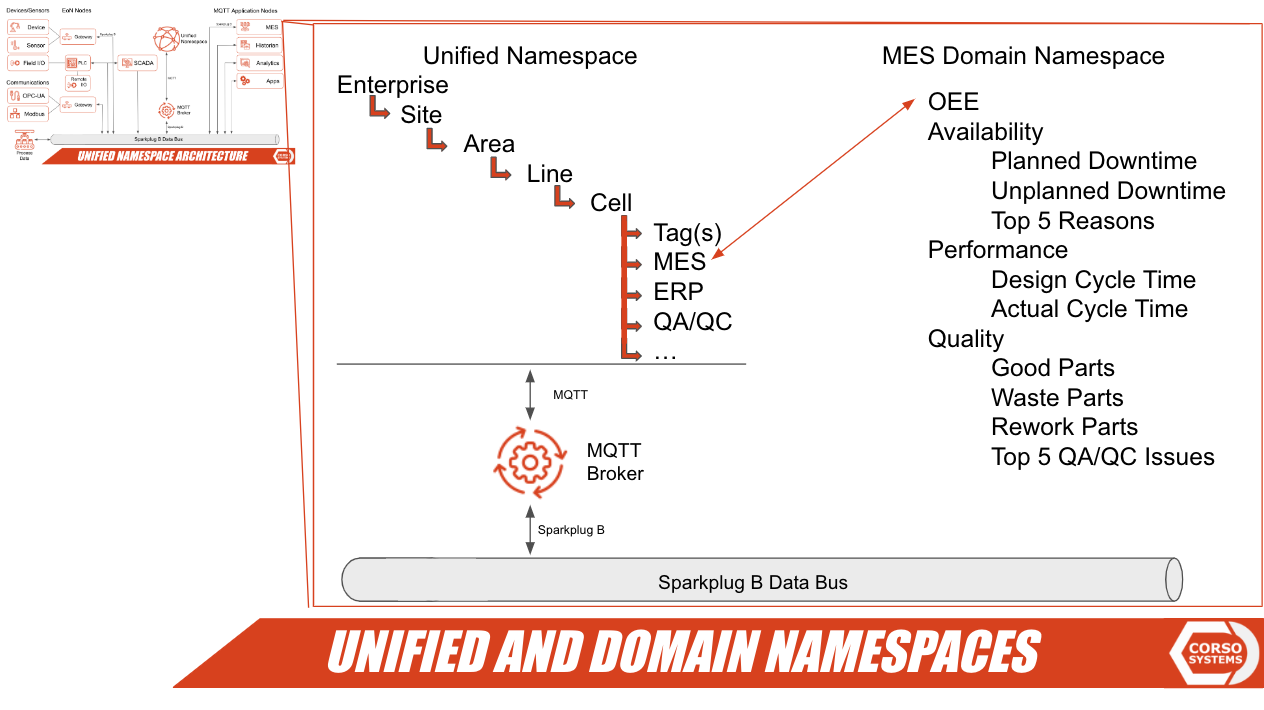Fast Digital Transformation with a Unified Namespace
We rarely find identical equipment designs on a given plant floor—and this has been the case with nearly every manufacturing company we’ve worked with over many years.
Especially with small to medium manufacturers, we might see machines made in different decades with different hardware working side by side with equipment supplied by different OEMs over the years. Many times companies will repurpose different types of equipment to fit a particular production line’s needs.
All of these different machines and configurations keeps us busy with many projects as systems integrators! Plant management, business owners (and nearly every user of the SCADA and MES systems we work with) want to see consistent data for all of their operations—regardless of the data’s source.
At Corso Systems, we have found that the best approach is to apply a Unified Namespace to the data we need to collect and manage for the process and the business. While this strategy adds a layer of abstraction between the specific pieces of equipment on the plant floor and the user, it also allows us to normalize the data so it can be compared and contrasted. As an added benefit, we can still incorporate the specific data for each individual piece of equipment directly in the Unified Namespace. Now, people who need to dig deeper into the data can use the same tools they used to access and analyze the normalized data.
Get Access to ALL of Your Data
A Unified Namespace expands to encompass your entire operation as compared to a traditional SCADA approach that only collects the data you need to see on the screen from your processes.
Now, the process data will still come through your SCADA system as before, but it will also go through the Unified Namespace so you can access Manufacturing Execution System (MES) data, business system data, and even data from any other apps or services you rely on to run your operations. Plus, all of this data will be brought into the Unified Namespace with your business hierarchy built in. Now, you can easily find the data you need—and it will be where you expect to find it. You’ll have the context to better understand the intricate interactions between every moving part of your business.
By breaking down data into relevant sections within the Unified Namespace you can separate the specific tags and data points from your machine into a defined structure. This gives folks who operate at a “higher” level, meaning further away from the specific values on the process floor the ability to understand what is going on by looking at OEE data for example. Your operators and maintenance technicians can then drill down into the specific data from each piece of equipment if they need to do troubleshooting, and this all requires no additional work to manage the flow of information across the company.
Standardize Data Models Across Your Enterprise
Another benefit to a Unified Namespace approach is it can standardize the data models across your entire enterprise.
Very different facilities are often acquired over time for large scale manufacturing situations. When this happens, the process controls and equipment come under a new umbrella. In these scenarios, it’s highly likely that you will never see uniform equipment across these different facilities—and that can lead to frustrating difficulties when integrating a corporate level structure into the mix.
By using a Unified Namespace approach to manage your data and information, you can build standards at the corporate level which can apply to any piece of equipment in any facility. Now, anyone at the company can examine the data from any facility and make sense of what is going happening with production.
Using a Unified Namespace even helps manage the cultural shifts that are required for successful digital transformation projects. During a presentation at ICC 2023, Chris Windmeyer of Tyson Foods walked through their implementation of this exact approach.
Chris and his team figured out the information needs and structure at the corporate level, then worked with each facility to implement the Unified Namespace. He gave each facility level team the corporate Unified Namespace requirements, and granted them the freedom to implement the system as they saw fit.
Because each facility level team built their own solution (following the guidelines for interfacing with corporate level data requirements) they had instant buy-in. They knew that they could still manage the their own facility level requirements by adding additional nodes and layers to the Unified Namespace structure. Ultimately, Tyson Foods’ projects got the best of all worlds with the data corporate needed to understand operations at each facility—and the teams at each facility taking pride in what they built.
Wrapping Up
It’s amazing, but you can help transform an entire organization with the choices around structuring your data.
Normally, systems integration is so focused on the technology itself and how we can use it optimize and streamline operations. But, it’s so important that the critical component of a company’s culture is a big part of these otherwise highly technical discussions.
In the same way that a Unified Namespace helps to structure and organize information to improve efficiency, it can also improve how invested your people are in your success. They’ll understand and take ownership in the process of helping you make it happen!
Ready to transform your business
with a Unified Namespace?
Contact us with your project information,
or schedule a short call with Cody Johnson in sales to get started ASAP.


